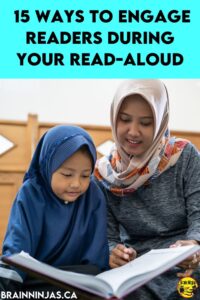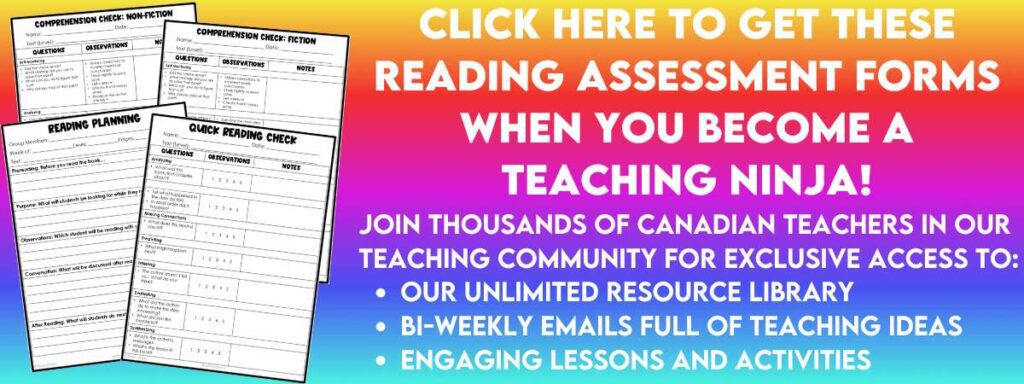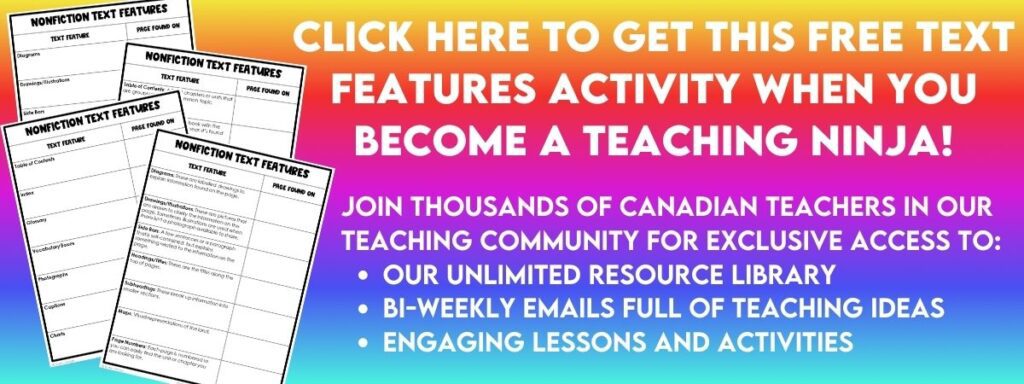
It seems that there is less and less time for reading aloud to your students, but if you use that read-aloud to engage your readers, you can teach so many different skills. Kids (and adults) of all ages love to be read to. If that weren’t the case, there wouldn’t be a thriving industry of audiobooks.
Administrators want teachers to focus their time on literacy and numeracy. Things like read-alouds seem like “entertainment,” but there is so much value in reading aloud to children. Come learn how we turn every read-aloud into a lesson (without our students even knowing it).
We have tried to collect ideas that could be used for any book, but some skills lend themselves better to fiction or nonfiction texts. The best part about these activities is that they don’t require lots of planning to do. They can work with almost any text you read in your classroom.
Are you looking for ways to help assess the comprehension skills of your students? Use this list of comprehension questions. It’s available in our Resource Library to members of our email list. If you’re not on the list, we can send it directly to your inbox.
Model Self-Monitoring
As you read, when you make an error, you’ll likely automatically fix it and move on. But, before you fix it, model how you think through the mistake. Did you say the word wrong? Did you miss the punctuation? Was the punctuation used correctly? When you make a mistake, explain what you did wrong and talk aloud, showing students the process. Reread the word, sentence, or paragraph again to show the error is fixed.
Aside from teaching students how to self-monitor, it’s important to show students that all readers make mistakes, but understanding how to fix them will make you a stronger reader.
Making Predictions

We often make predictions before we read by looking at the cover, reading the title, reading the back of the book, or reading the first sentence. Don’t forget to make predictions throughout the reading. What do you think will happen next? Do you think ____ will happen? Ask students to give you a reason and, when possible, give you evidence as to why.
Most importantly, check back in and see if your predictions were right. Without this step, you’re merely going through an exercise. What evidence is there that the prediction is right or wrong?
Making a correct prediction does not necessarily indicate a reader understands. It could be a lucky guess. It’s more important that students can identify the evidence that either proves or disproves the predictions.
Expand Vocabulary
When you come to an interesting word, ask students if they know the definition. Talk about how you can learn the definition. Teach students to use context clues and, when those don’t work, how to look the word up. Make a list of the interesting words you come across during your reading and challenge students to use them in their own writing.
Model Fluency
We often equate fluency to reading without errors, but there is much more to it. Fluency is reading in such a way that the audience listening can easily follow along. When students struggle to read independently, they lose the ability to read fluently (which often means that what they are reading becomes difficult to follow).
Model Expression

Students often think reading with expression means reading with an exciting voice, but that’s not quite it. We teach our students that reading with expression means reading it with the author’s intent. Is the voice supposed to be jovial or scary? Where are the pauses supposed to be? This means stressing specific words, using punctuation, and reading the phrases and clauses as the author wanted them to be read.
Make Connections
If you’ve ever read something to students, there will always be one who will tell you a story about something only slightly related. While this might be annoying when you have a lesson to get through, you should reward the fact that the student has just made a connection. This is often known as a text-to-self connection.
Instead of everyone sharing their personal story, look for opportunities to make other connections to the text: text-to-text or text-to-the-world. How is this book like other books we’ve read? How is this story like the information we learned about in social studies?
Retell What You’ve Read
If you are reading a novel, the first thing you can do is ask a student to remind you what happened the last time you read. This helps hone the skills of students to retell the most important information. It can also work to ask a student to retell what has happened so far to catch up the students who may have been away.
Teach Text Features
We often assume that students automatically know why certain words are highlighted, in italics, have headings or are in text boxes. Informational text usually has more text features. Show these features to your class each time you read. How do they help people navigate the text? Show students the order to read information that is found along the side.
We have an activity you can use to teach text features. It’s available in our Resource Library or we can send it directly to your inbox when you sign up for our email list.
If you’re looking to read more about teaching text features in a variety of subject areas read our post Research Skills: How to Teach Text Features.
Study the Genre
What is the genre of the text you are reading? This can start with informational or fictional and slowly work through the classifications until you get into specific genres. If you’re looking for some definitions along with possible books to use, check out this post from Scholastic.
Analyze the Plot
Once you’ve read a section of the book, talk about the different points throughout the plot. Map it out. Your plot map could be as simple as a list of events or you could draw a detailed storyline.
Talk About the Character Traits

Surprisingly, we found that students had a difficult time talking about the character traits of the different characters in the story. Some of this was the lack of vocabulary to describe certain traits. Others missed the traits during “show, don’t tell” moments. This is where inferences are important.
For example, a character who stomped her feet, then slammed the door and burst into tears. Students would say sad. That’s typical. But they would miss that she was angry and frustrated and that something must have happened to make her that way.
Traits are different than emotions (and this is where students struggle). Make a list of the character traits (and their meanings if necessary) for the books you read. What patterns do you see? How does the character grow or change?
Find the Perspective
During your read-aloud, stop to ask questions about the perspective of the story. From which point of view is the story written? Why would the author choose this? How does this perspective drive the story or withhold information from the reader?
Talk about how there is evidence about the perspective (I, she etc.).
Talk About the Setting
Where does the story take place? Is it s real place or is it fictional? When does it take place? Is it during a real event or an imaginary one? What time of day does the action happen? How quickly (or slowly) does time pass during the story?
Chat About the Author’s Intent

If you were to ask students to think about the author’s intent, they would just stare back at you with a blank face. Why did the author choose to write the text? What is the purpose of the text? Does it accomplish what the author intended?
Evaluate the Text
The simplest way to have students evaluate the text is to ask them to rate it.
However, the evaluation will be more valuable if you attach criteria to it. Maybe you’re rating the book on entertainment value, or information value. Make a list of ways students can assess what they are reading and then use that as the criteria. You will likely need to have different criteria for different genres.
And don’t forget…
It’s okay to read aloud a favourite book just for the pure joy of reading. Studies show that the majority of parents stop reading to their children around the age of eight. As a classroom teacher, you’re probably one of the only people still reading to them on a regular basis. Even junior high students love to be read to (yes, really, just tell them it’s a podcast). You are allowed to show students that reading can be for fun.
Looking For Some Read-Aloud Ideas?
Learn the Truth With Books by Indigenous Authors
Books For and About Powerful Women
Black History Books You Should Use All Year
Cozy Up With Great Winter Books
Books You’ll Love With LGBTQ+ Characters
Christmas Books We Love
Books About Kindness That Should Be in Every Classroom
Picture Books for Lunar New Year
Memorable Books for Remembrance Day in Canada
Books for Social Emotional Learning for Kids
Books for Earth Day
Orange Shirt Day (Residential Schools)
Books About Thanksgiving
Asian Heritage Month
Your Big List of Must-Have Books for Ramadan and Eid
What else?
This is definitely not an exhaustive list. There are many more skills you could teach using a read-aloud (aside from the information in the actual text). What other skills can you teach with a read-aloud? Tell us about it in the comments below.








